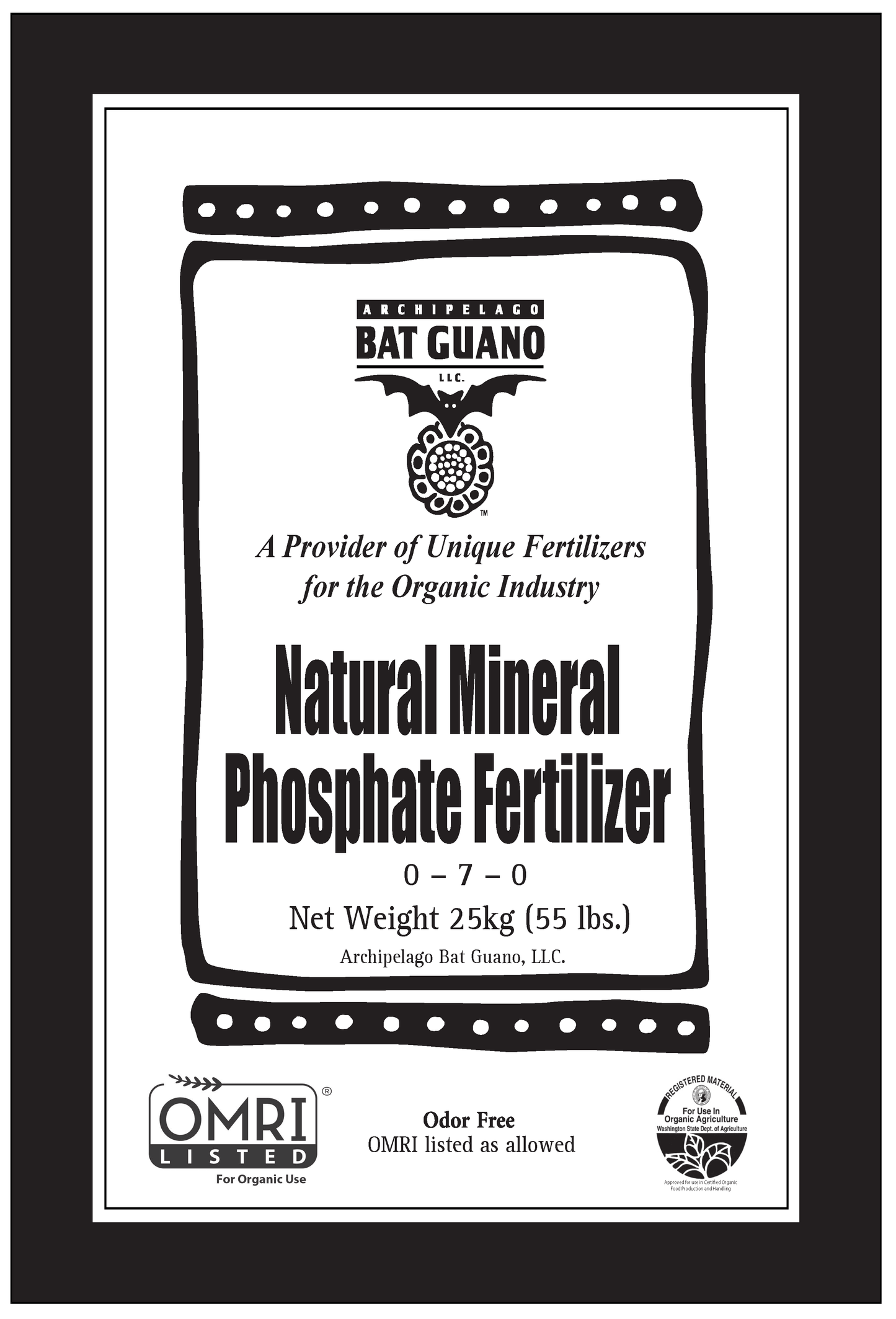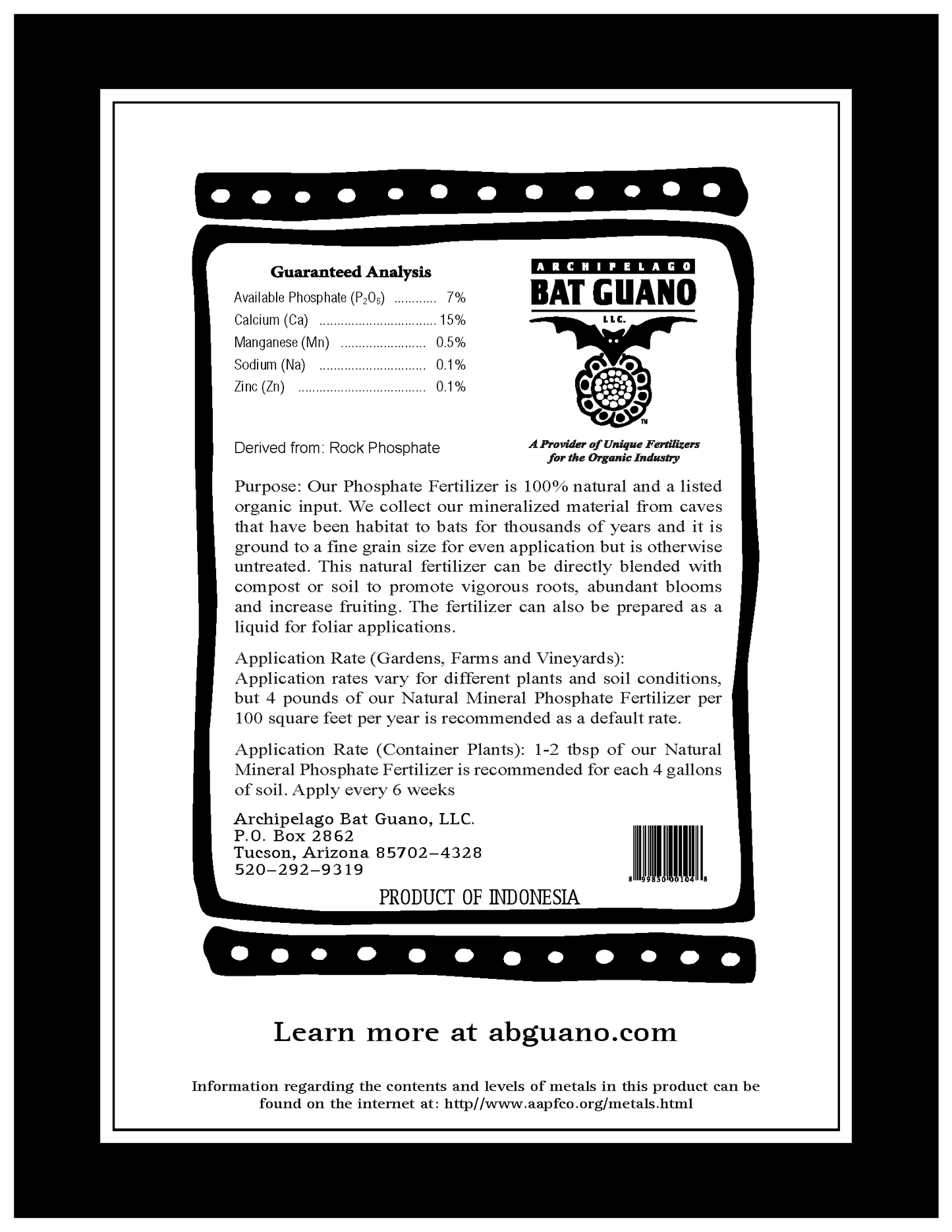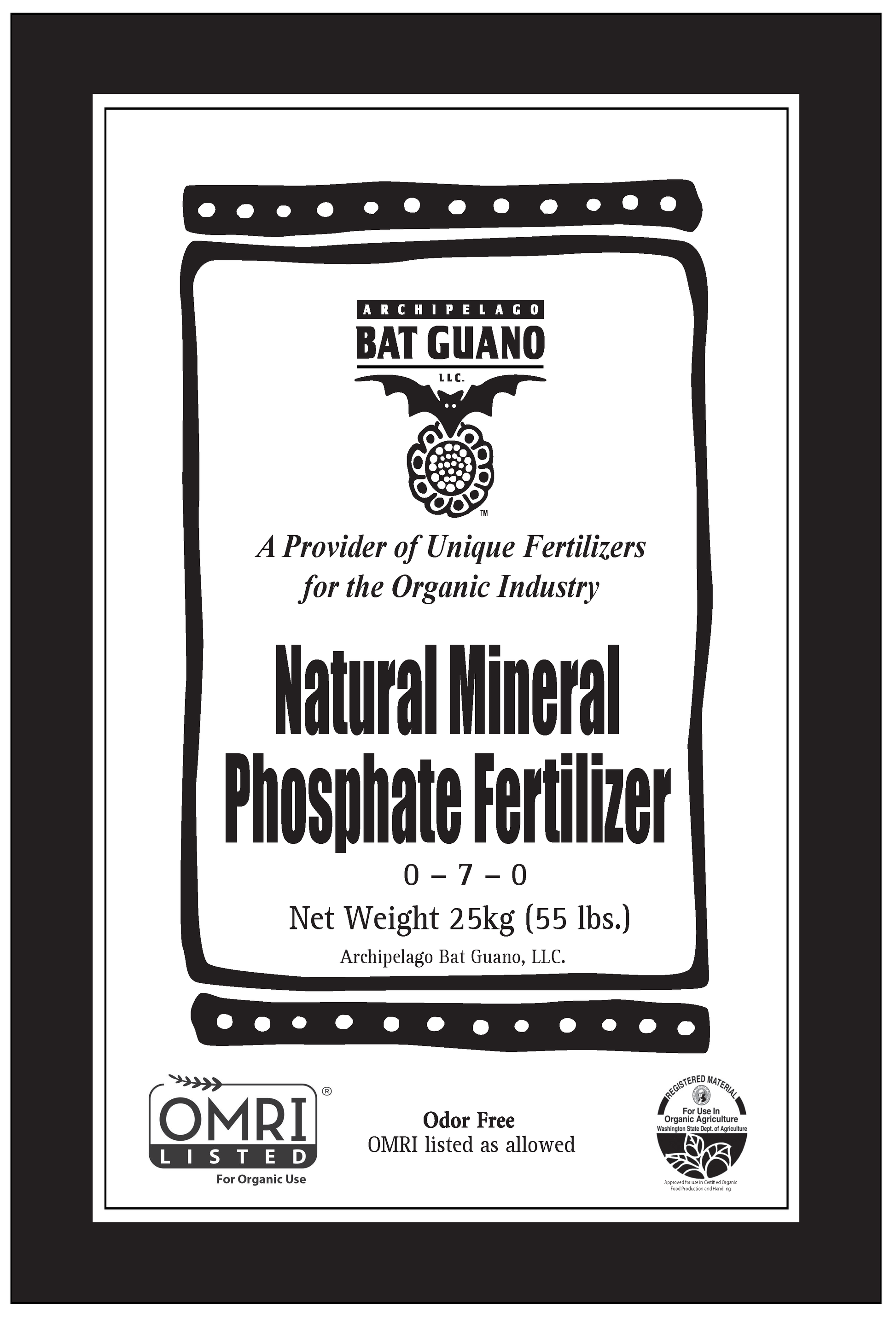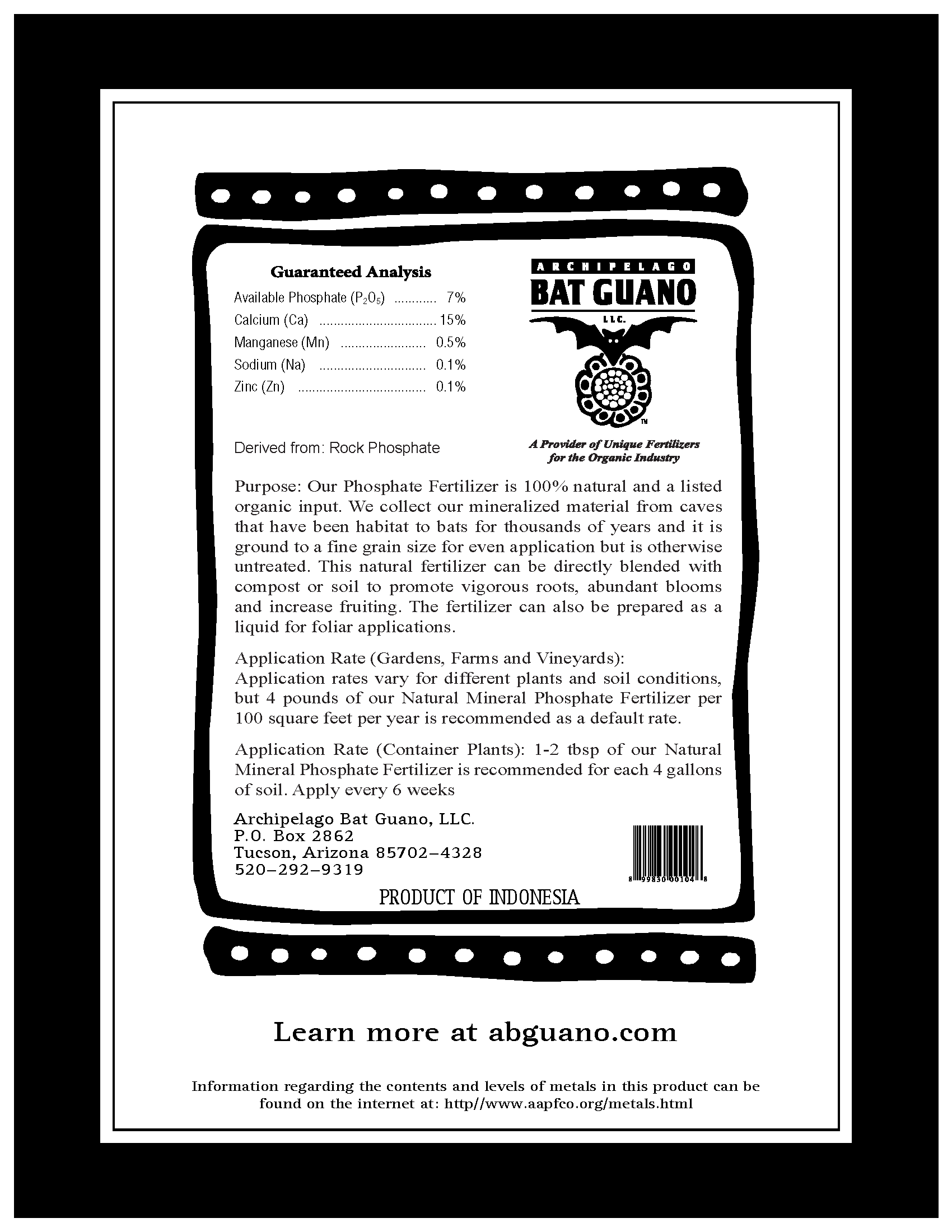Item Number: F6010
Archipelago Bat Guano 0-7-0 (55 lb)
Archipelago Bat Guano 0-7-0 (55 lb)
Good for root development, blooms and fruiting
Archipelago Bat Guano: Nature's Fertilizer Treasure
In the realm of natural fertilizers, Archipelago Bat Guano stands as a testament to the profound impact of accumulated excrement on agricultural endeavors. Located on an island off the coast of Peru, this resource has played a pivotal role in the world's agricultural history, particularly during the 19th century. Let's explore the origins, significance, and utilization of this unique natural substance.
Island Off the Coast of Peru: Home to a Natural Wonder
The Archipelago Bat Guano finds its home on uninhabited islands off the coast of Peru. These remote and unpopulated territories, once unnoticed, hold immense value due to the extraordinary natural processes occurring within their ecosystem. Here, thousands of birds, particularly the guanay cormorant, congregate to roost and breed, creating an environment conducive to the production of bird guano, a highly sought-after fertilizer.
The Birth of a Fertilizer Empire: 19th Century's Guano Rush
During the 19th century, the world underwent a guano rush as the Peruvian government recognized the agricultural significance of bird guano. This resource became a critical commodity for global agriculture, especially in Europe and the United States. The mineral-rich excrement from these islands was prized for its unparalleled fertilizing properties, providing essential nutrients such as nitrogen, phosphorus, and potassium vital for crop growth.
Peruvian Government and the Guano Industry
The Peruvian government capitalized on this abundant natural resource, asserting its control over the guano-rich islands. Recognizing the economic potential, the government established regulations and concessions, allowing extraction and exportation of the guano, which led to significant revenues. This resource quickly became a driving force for the nation's economy during this period.
Nature's Fertilizer: The Value of Bat Guano
Archipelago Bat Guano is a result of accumulated excrement from various bird species, primarily the guanay cormorant, which, in combination with other seabirds, contributed to the formation of vast deposits. This bird guano, due to its rich composition of nitrogen, phosphorus, and potassium, served as a potent natural fertilizer that significantly enhanced soil fertility and crop yields. Its effectiveness made it a highly sought-after resource for agricultural practices worldwide.
Utilization in Agriculture and Beyond
The significance of bat guano in agriculture cannot be overstated. It served as a fundamental element in replenishing soil nutrients, improving crop growth, and increasing agricultural productivity. Beyond its role in farming, guano found applications in various industries, including the production of explosives, due to its high nitrogen content.
Environmental Impact and Conservation
The extraction of guano from these islands during the 19th century had a profound environmental impact, leading to the depletion of guano deposits and disturbance in the delicate ecosystem of the seabird colonies. As a result, regulations were put in place to protect these natural reserves, focusing on conservation efforts to preserve the fragile balance of the uninhabited islands and their resident bird populations.
Modern-Day Significance and Sustainability
While the guano rush of the 19th century has subsided, the value of Archipelago Bat Guano endures. With increased awareness of sustainable agricultural practices, there's a renewed interest in organic and natural fertilizers, reigniting the appreciation for guano's nutrient-rich composition. Efforts toward responsible harvesting and conservation aim to sustain these natural resources for future generations.
Nature's Gift Preserved
Archipelago Bat Guano, born from the accumulated excrement of seabirds on uninhabited islands off Peru's coast, remains a testament to the intricate balance of nature and its significance in global agriculture. While the guano rush of the 19th century brought this resource to the forefront of agricultural practices, modern efforts focus on sustainable utilization and conservation, ensuring the preservation of this invaluable natural treasure for years to come.
Guaranteed Analysis: Available Phosphate 7%, Calcium 15%, Manganese 0.5%
Derived from Rock Phosphate
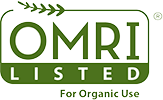
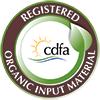

Check Your Zone Compatibility:
Compatible with your zone.
Growing Zone for
,

Our Guarantee To You
Since 1976, we've served our customers at every stage of growing. Please contact us at any time. We are happy to support and assist you.
Description
Description
Archipelago Bat Guano: Nature's Fertilizer Treasure
In the realm of natural fertilizers, Archipelago Bat Guano stands as a testament to the profound impact of accumulated excrement on agricultural endeavors. Located on an island off the coast of Peru, this resource has played a pivotal role in the world's agricultural history, particularly during the 19th century. Let's explore the origins, significance, and utilization of this unique natural substance.
Island Off the Coast of Peru: Home to a Natural Wonder
The Archipelago Bat Guano finds its home on uninhabited islands off the coast of Peru. These remote and unpopulated territories, once unnoticed, hold immense value due to the extraordinary natural processes occurring within their ecosystem. Here, thousands of birds, particularly the guanay cormorant, congregate to roost and breed, creating an environment conducive to the production of bird guano, a highly sought-after fertilizer.
The Birth of a Fertilizer Empire: 19th Century's Guano Rush
During the 19th century, the world underwent a guano rush as the Peruvian government recognized the agricultural significance of bird guano. This resource became a critical commodity for global agriculture, especially in Europe and the United States. The mineral-rich excrement from these islands was prized for its unparalleled fertilizing properties, providing essential nutrients such as nitrogen, phosphorus, and potassium vital for crop growth.
Peruvian Government and the Guano Industry
The Peruvian government capitalized on this abundant natural resource, asserting its control over the guano-rich islands. Recognizing the economic potential, the government established regulations and concessions, allowing extraction and exportation of the guano, which led to significant revenues. This resource quickly became a driving force for the nation's economy during this period.
Nature's Fertilizer: The Value of Bat Guano
Archipelago Bat Guano is a result of accumulated excrement from various bird species, primarily the guanay cormorant, which, in combination with other seabirds, contributed to the formation of vast deposits. This bird guano, due to its rich composition of nitrogen, phosphorus, and potassium, served as a potent natural fertilizer that significantly enhanced soil fertility and crop yields. Its effectiveness made it a highly sought-after resource for agricultural practices worldwide.
Utilization in Agriculture and Beyond
The significance of bat guano in agriculture cannot be overstated. It served as a fundamental element in replenishing soil nutrients, improving crop growth, and increasing agricultural productivity. Beyond its role in farming, guano found applications in various industries, including the production of explosives, due to its high nitrogen content.
Environmental Impact and Conservation
The extraction of guano from these islands during the 19th century had a profound environmental impact, leading to the depletion of guano deposits and disturbance in the delicate ecosystem of the seabird colonies. As a result, regulations were put in place to protect these natural reserves, focusing on conservation efforts to preserve the fragile balance of the uninhabited islands and their resident bird populations.
Modern-Day Significance and Sustainability
While the guano rush of the 19th century has subsided, the value of Archipelago Bat Guano endures. With increased awareness of sustainable agricultural practices, there's a renewed interest in organic and natural fertilizers, reigniting the appreciation for guano's nutrient-rich composition. Efforts toward responsible harvesting and conservation aim to sustain these natural resources for future generations.
Nature's Gift Preserved
Archipelago Bat Guano, born from the accumulated excrement of seabirds on uninhabited islands off Peru's coast, remains a testament to the intricate balance of nature and its significance in global agriculture. While the guano rush of the 19th century brought this resource to the forefront of agricultural practices, modern efforts focus on sustainable utilization and conservation, ensuring the preservation of this invaluable natural treasure for years to come.
Guaranteed Analysis: Available Phosphate 7%, Calcium 15%, Manganese 0.5%
Derived from Rock Phosphate
Shipping Information
Shipping Information
Cannot ship to the following states: AL, AK, AR, CT, DE, FL, GA, ID, IL, IN, IA, KS, KY, LA, ME, MD, MA, MI, MN, MS, MO, MT, NE, NV, NH, NJ, NM, NY, NC, ND, OH, OK, OR, PA, RI, SC, SD, TN, TX, UT, VT, VA, WV, WI, WY, VI, PR, GU
Does not qualify for Flat Rate Shipping.
Shipping Weight: 55.0 lb
Dimensions: 23.0"L x 14.0"W x 4.0"H
Features
Features
Characteristics
Characteristics
Use Instructions
Use Instructions
Useful Information
Useful Information
Guarantee
Guarantee
Share
